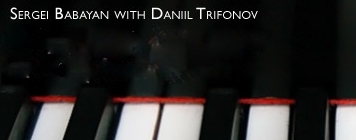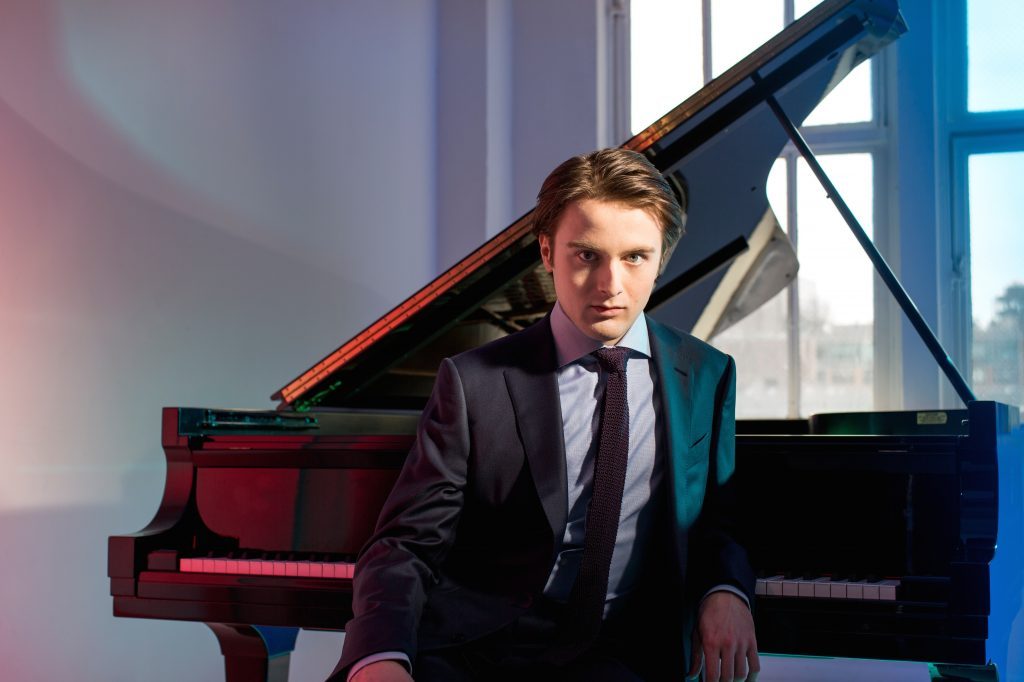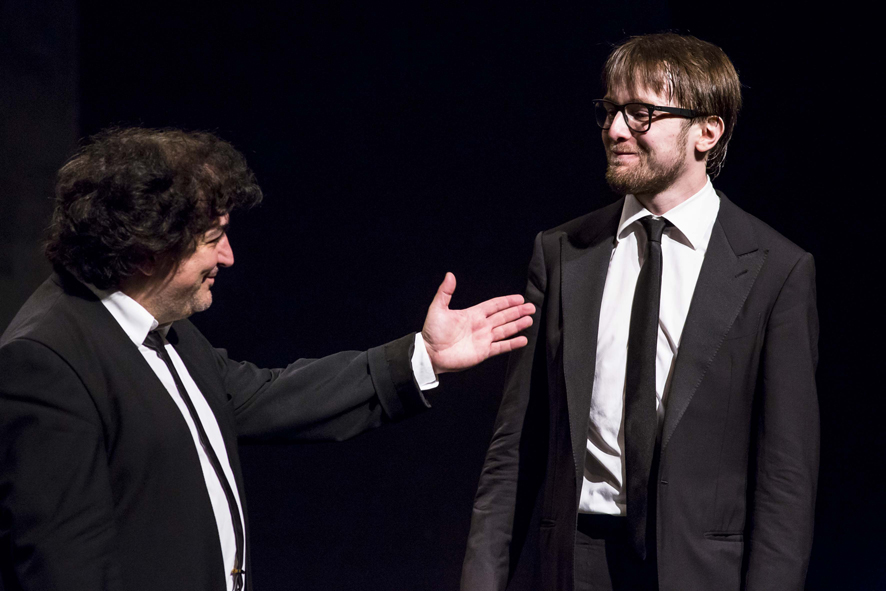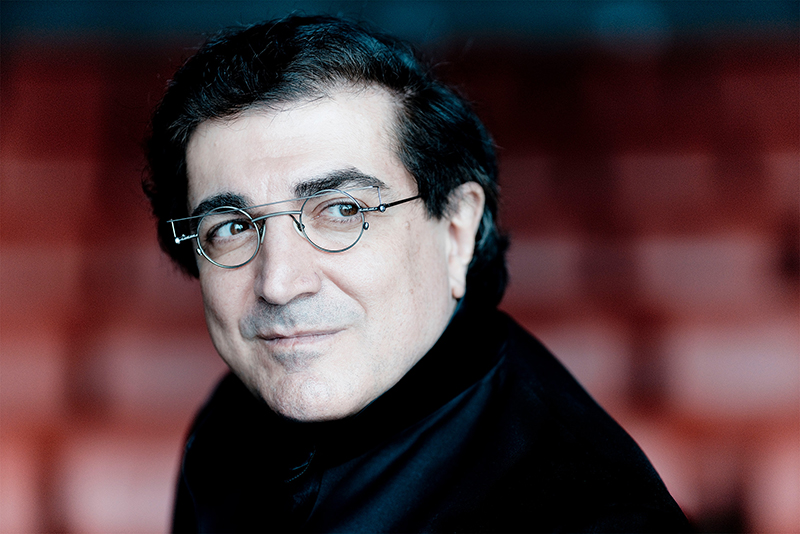A WELL-MATCHED TEACHER AND STUDENT
One of our greatest living pianists — if not the greatest — Daniil Trifonov (dan-EEL TREE-fon-ov) came to Disney Hall for a solo recital exactly two years ago. He played a gargantuan program lasting over 160 minutes. Included were the Brahms Chaconne in D minor for the Left Hand (after Bach’s famous Partita for Solo Violin); the Sonata in G major, D. 894 by Schubert; the Brahms Variations on a Theme by Paganini, Op. 35, Book 1; the monstrous Sonata No. 1 in D minor, Op. 28 by Rachmaninoff; and three encores. It was precisely the kind of program that fans and the curious should expect. As in his concert performances, this pianist for the ages combined flawless skill with a fierce tenderness that was a performance of a lifetime.
But his visit with violinist Gidon Kremer in 2015, and more importantly his two-piano performance with mentor Sergei Babayan last Sunday night at Disney Hall in Los Angeles, were programmatically different, eschewing many show-off works for subtlety. Originally scheduled with a Ravel and the premiere of a work by Mauro Lanza (co-commissioned by Carnegie Hall), the concert now has pieces by Schumann, Pärt, and Mozart in the tranquil first half, and exciting Rachmaninoff (who Trifonov is fervent about) works in the second half.
The Andante and Variations in B-flat major is an interesting item in Schumann’s catalog. Written soon after the piano quintet and piano quartet, it is also piano-driven, but scored for the unusual combination of two pianos, two cellos, and one horn. Although Schumann was disappointed with the work and withdrew it from his catalog, he re-published it, omitting two variations — as well as the introduction and the interlude — into a two-piano form as Op. 46 (at Mendelssohn’s suggestion). Only in sections is it a showpiece of Liszt-like arpeggiated chords, but the duo offered plenty of warmth and vitality, echoing each other perfectly (an amazing feat given that the keyboards faced opposite sides of the stage). They brought out the intrinsic charm, interesting harmonies, rich textures, and simple direct melodies of the piece.
Estonian composer Arvo Pärt’s Pari intervallo was a curious choice. Sublime and ephemeral, very even-toned and hushed, it was a meditative experience that kept the crowd rapt. At times their playing was so subtle and quiet that one had to strain to hear the notes. It is a tribute to the acoustics in Disney Hall that the audience was able to do that, but it also placed huge demands on our attention.
As with all of Mozart’s sonatas, his D major, K. 448 — one of his few compositions for two pianos — is written in strict sonata-allegro form with three movements (with the audience applauding wildly after the first). Mozart wrote this in the galant style, with interlocking melodies and simultaneous cadences. In this — one of his few compositions written for two pianos — the performers exquisitely divided the main melody for the exposition with even-handed volume, and when the theme is presented, both played it simultaneously as if it were coming from one hand — and their fluttery, buttery arpeggios were sterling. The entire second movement is played Andante, in a very relaxed pace, yet it was surprisingly engaging. Even with perfect playing, one can’t call the piece “exciting.” With the stage behind them bathed in blue light, how relaxing was it? According to the British Epilepsy Organization, research has suggested that Mozart’s K 448 can have the “Mozart effect,” in that listening to the piano sonata improved spatial reasoning skills and reduce the number of seizures in people with epilepsy.
The most striking thing about the program’s second half — two Rachmaninoff suites in four movements — was the precision and the fluidity, even better than Martha Argerich & Stephen Kovacevich’s recital last year (Babayan and Argerich are set to release a CD of Prokofiev duets). There were so many notes that I’m surprised the page turners didn’t run out of breath (none of the pieces were memorized). I especially loved the third movement in the first suite (Op. 5), which sounds like beautiful tolling bells (a Russian cultural element sometimes used to communicate social events) and chirping birds. The performers explored the tonal variety while maintaining a quickened pace, and the heightened tensions made for a beautiful experience. They created sounds both theatrical and expressive, but Babayan really impressed with his double octave work in the second suite (Op.17). This suite displays Rachmaninoff’s keyboard characteristics, and these gentlemen were perfectly suited for the intense Russian flavor, rich and bold sonorities, compelling rhythmic drive, and brilliant virtuosity. The languid and highly melodic “Romanza” is followed by a “Tarantella” finale, in which an Italian folk music theme is presented by each of the two players for a white-knuckle dialogue that rushes the rouser to a high-spirited ending.
A wild response brought the dyad back with an encore of a selection from Rimsky-Korsakov’s opera The Snow Maiden: “Dance of the Tumblers,” arranged by Victor Babin. This lively, energetic work is used for developing players to master the tricky eighth and sixteenth note passages, so it’s a perfect choice for the master and student at hand(s). I think had the programming contained more fireworks, there would have been a demand for further encores, but the applause died down immediately after the “Dance.”
Playing on a Steinway New York and a Steinway Hamburg, the teacher and student weren’t just different in playing styles: The Armenian-American Babayan, 57, is short and stout with thick black locks, while the Russian Trifonov, 27 and getting handsomer by the year, is skinny with thin hair. Babayan rarely moved his positioning, while Trifonov (who just won a 2018 Grammy for Best Classical Instrumental Solo for his album Transcendental) hunched over the keys or occasionally bounced emphatically like he was galloping on a horse. Trifonov has a lighter, feathery touch – while allowing each melodic line to be clearly articulated — and Babayan was more resounding, but the well-matched pair hushed Disney Hall with their sensitivity, emotion, and virtuosity.
photo of Babayan and Trifonof by Nicolas Brodard
photo of Trifonov by Dario Acosta
Daniil Trifonov and Sergei Babayan
prsented by LA Phil at Disney Hall
played Sunday, February 25, 2018
for more events, visit LA Phil




